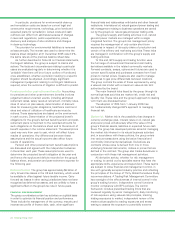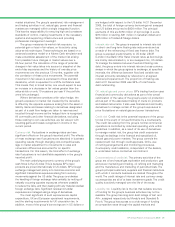BP 2005 Annual Report Download - page 36
Download and view the complete annual report
Please find page 36 of the 2005 BP annual report below. You can navigate through the pages in the report by either clicking on the pages listed below, or by using the keyword search tool below to find specific information within the annual report.34 Making energy more
Where the group has transferred its rights to receive cash flows
from an asset and has neither transferred nor retained substantially
all the risks and rewards of the asset nor transferred control of the
asset, the asset is recognized to the extent of the group’s continuing
involvement in the asset. Continuing involvement that takes the form
of a guarantee over the transferred asset is measured at the lower
of the original carrying amount of the asset and the maximum amount
of consideration that the group could be required to repay.
Where continuing involvement takes the form of a written and/or
purchased option (including a cash-settled option or similar provision)
on the transferred asset, the extent of the group’s continuing
involvement is the amount of the transferred asset that the group may
repurchase, except that in the case of a written put option (including a
cash-settled option or similar provision) on an asset measured at fair
value, the extent of the group’s continuing involvement is limited to
the lower of the fair value of the transferred asset and the option
exercise price.
Financial liabilities A financial liability is derecognized when the
obligation under the liability is discharged, cancelled or expires.
Where an existing financial liability is replaced by another from the
same lender on substantially different terms or the terms of an
existing liability are substantially modified, such an exchange or
modification is treated as a derecognition of the original liability
and the recognition of a new liability, such that the difference in the
respective carrying amounts, together with any costs or fees incurred
are recognized in profit or loss.
DERIVATIVE FINANCIAL INSTRUMENTS
The group uses derivative financial instruments to manage certain
exposures to fluctuations in foreign currency exchange rates, interest
rates and commodity prices. From 1 January 2005, such derivative
financial instruments are initially recognized at fair value on the date
on which a derivative contract is entered into and are subsequently
remeasured at fair value. Derivatives are carried as assets when the
fair value is positive and as liabilities when the fair value is negative.
Contracts to buy or sell a non-financial item that can be settled net
in cash or another financial instrument, or by exchanging financial
instruments, as if the contracts were financial instruments, with the
exception of contracts that were entered into and continue to be held
for the purpose of the receipt or delivery of a non-financial item in
accordance with the group’s expected purchase, sale or usage
requirements, are financial instruments.
For those derivatives designated as hedges and for which hedge
accounting is desired, the hedging relationship is documented at
its inception. This documentation identifies the hedging instrument,
the hedged item or transaction, the nature of the risk being hedged
and how effectiveness will be measured throughout its duration.
Such hedges are expected at inception to be highly effective.
For the purpose of hedge accounting, hedges are classified as:
••• Fair value hedges when hedging the exposure to changes in the fair
value of a recognized asset or liability;
••• Cash flow hedges when hedging exposure to variability in cash
flows that is either attributable to a particular risk associated with
a recognized asset or liability or a highly probable forecast
transaction, including intra-group transactions; or
••• Hedges of the net investment in a foreign entity.
Any gains or losses arising from changes in the fair value of all other
derivatives, which are classified as held for trading, are taken to the
income statement. These may arise from derivatives for which hedge
accounting is not applied because they are either not designated or
not effective as hedging instruments or from derivatives that are
acquired for trading purposes.
TRADE AND OTHER RECEIVABLES
Trade and other receivables are carried at the original invoice amount,
less allowances made for doubtful receivables. Where the time value
of money is material, receivables are carried at amortized cost.
Provision is made when there is objective evidence that the group will
be unable to recover balances in full. Balances are written off when
the probability of recovery is assessed as being remote.
CASH AND CASH EQUIVALENTS
Cash and cash equivalents comprise cash in hand; current balances
with banks and similar institutions; and short-term highly liquid
investments that are readily convertible to known amounts of cash,
are subject to insignificant risk of changes in value and have a maturity
of three months or less from the date of acquisition.
For the purpose of the group cash flow statement, cash and cash
equivalents consist of cash and cash equivalents as defined above,
net of outstanding bank overdrafts.
TRADE AND OTHER PAYABLES
Trade and other payables are carried at payment or settlement
amounts. Where the time value of money is material, payables
are carried at amortized cost.
INTEREST-BEARING LOANS AND BORROWINGS
All loans and borrowings are initially recognized at cost, being the
fair value of the proceeds received net of issue costs associated with
the borrowing.
After initial recognition, interest-bearing loans and borrowings are
subsequently measured at amortized cost using the effective interest
method. Amortized cost is calculated by taking into account any issue
costs, and any discount or premium on settlement.
Gains and losses arising on the repurchase, settlement or
cancellation of liabilities are recognized respectively in interest and
other revenues and other finance expense.
LEASES
Finance leases, which transfer to the group substantially all the
risks and benefits incidental to ownership of the leased item, are
capitalized at the inception of the lease at the fair value of the leased
property or, if lower, at the present value of the minimum lease
payments. Lease payments are apportioned between the finance
charges and reduction of the lease liability so as to achieve a constant
rate of interest on the remaining balance of the liability. Finance
charges are charged directly against income.
Capitalized leased assets are depreciated over the shorter of the
estimated useful life of the asset or the lease term.
Operating lease payments are recognized as an expense in the
income statement on a straight-line basis over the lease term.
DERECOGNITION OF FINANCIAL ASSETS AND LIABILITIES
Financial assets A financial asset (or, where applicable, a part of a
financial asset or part of a group of similar financial assets) is
derecognized where:
••• The rights to receive cash flows from the asset have expired;
••• The group retains the right to receive cash flows from the asset,
but has assumed an obligation to pay them in full without material
delay to a third party under a ‘pass-through’ arrangement; or
••• The group has transferred its rights to receive cash flows from the
asset and either (a) has transferred substantially all the risks and
rewards of the asset or (b) has neither transferred nor retained
substantially all the risks and rewards of the asset but has
transferred control of the asset.
























